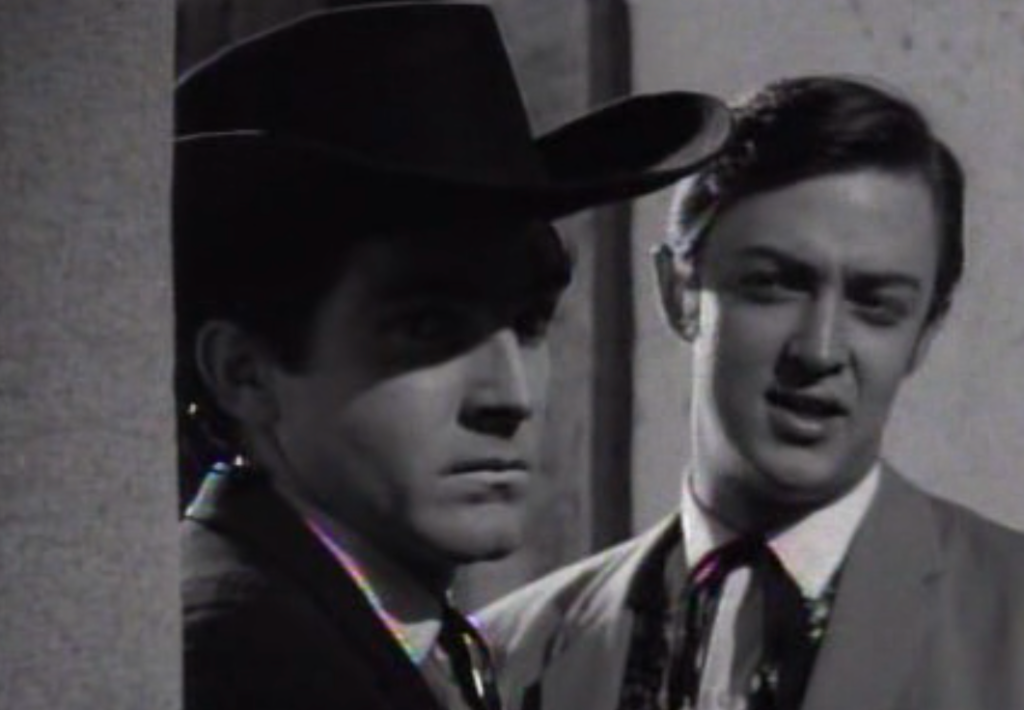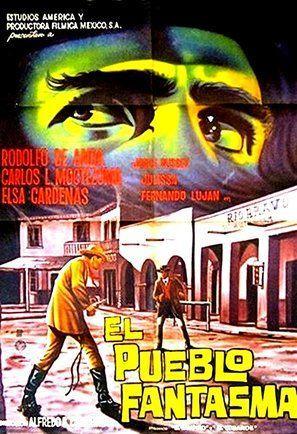‘Where I put my eye…I put the bullet!’
A young cowboy is looking for information about his late father, hoping to discover evidence to contradict his reputation as a vicious bandit. Tracking one of his old gang down to a border town, he finds the residents in the grip of a much deadlier terror…
An offbeat amalgamation of Western and horror from Mexican director Alfredo B Crevenna. The film was apparently cut together from a three-episode television show, but, for once, the small scale and appropriate budget are a help, not a hindrance.

Manuel Saldívar Jr (Rodolfo de Anda) is a man on a mission. Sick of hearing stories all his life about his late father’s murderous deeds down on the border, he is determined to find evidence there to the contrary and set the record straight. Unfortunately, it’s an uphill battle; peasants sing corridas in the street detailing his old man’s crimes, and he has to travel as ‘El Texano’ rather than reveal his true identity.
Crossing the desert, he saves the life of ex-convict Néstor Ramírez (Carlos López Moctezuma), who is returning home to the border town where his family still live. When they arrive, the new friends find a community living in fear. Moctezuma is surprised to find that his old nemesis, the Rio Kid (Fernando Luján), is still in residence and that a steady stream of outlaws and bandits are still arriving to test his mettle. But what’s worse than that, the corpses of the defeated gunfighters vanish after death, and the locals believe that these dead men walk the streets at night.

Mixing the supernatural and the Old West on the big screen was hardly new by the mid-1960s. Real-life ‘ghost towns’ had provided atmospheric backdrops for many a Hollywood Western in the studio era, and some had even featured fantastical elements, although these were always explained away. However, Edward Dein’s surprisingly effective B-Film ‘Curse of the Undead’ (1959) delivered an actual gunslinging vampire, and the concept was familiar enough that in the next few years, John Carradine was cashing his paycheque from ‘Billy the Kid Versus Dracula’ (1966).
The action opens in the local saloon of Crevenna’s unnamed border town where fast gun El rapido (Jorge Russek) is chugging whiskey and out to make his reputation as the man who bested the famous Rio Kid (Luján). Unfortunately for him, Lujan has a hidden ally in the film’s editor, and one quick jump cut later, Russek has been outdrawn and is on a one-way trip to Boot Hill. The same fate also awaits the brutal Rivera Brothers, Hermano (José Chávez) and Atenógenes (Guillermo Hernández), but what has the townsfolk spooked is the regular disappearance of the corpses of Luján’s victims.

A couple of factors really assist the drama in Crevenna’s film. The first is the restraint that is evident throughout. Proceedings are low-key for the most part, perhaps dictated by the limited production resources available, but ensuring a somewhat grounded result. The word ‘vampire’ isn’t even mentioned until the final act, although the bloodsucker’s physical appearance is pretty laughable, with his prominent canines more accurately described as tusks rather than teeth! A little goofy it may be, but it’s still a welcome change from the usual dinner-suited, aristocratic Lugosi template almost exclusively favoured by Mexican horror cinema since the box-office breakout of Abel Salazar’s ‘El vampiro’ (1957).
The director also knows how to marshal his resources to their best effect. There are very few location shots, with most of the drama taking place on studio sets, but it’s all quite convincing except for a couple of out-of-town scenes in the desert. It helps that most of the action takes place after dark, of course, and Crevenna can wreathe the pueblo’s narrow streets in heavy, atmospheric shadows. It also helps that we have a quietly compelling performance by Luján, who exudes a sense of evil while being rather a small, physically unimposing man.

Some of the story elements are a little trite, though, with a completely pointless semi-romance between de Anda and Moctezuma’s pretty daughter, Marta (Elsa Cárdenas). Instead, the heroine’s duties are split with singer Carmen (Julissa), who travels with her father, blind guitarist Don Beto (Rubén Márquez). Their inclusion also allows for some musical numbers, including a couple of takes of the corrida about de Anda’s bandit father, which drives our somewhat uptight hero to distraction.
As is usually the case with Mexican horrors of the era, there is little to no production information available for the film beyond its apparent genesis as a TV show. The finished product partially bears out this assertion as probably being the case. The introduction of Julissa and Márquez is rather sudden, and the three musical numbers are all clustered together in the middle of the film, which throws off the pacing. There’s also a complete lack of information regarding the vampire’s origins and only a scant explanation of what happened to all those corpses. It’s possible that those issues were more fully addressed in the original show.

Intriguingly, the film also appears to be a sequel to a more straightforward Western called ‘El texano’ (1965), which featured much of the same cast. Although sources list Moctezuma, Russek, and Cárdenas in different roles, de Anda again played Manuel Saldívar Jr, and the prolific Alfredo Ruanova is credited as screenwriter on both projects. Given those credits, it’s likely the projects were filmed back-to-back. However, there’s no production information available to suggest the exact circumstances or if the former film also originally appeared on the small screen.
Crevenna was a workhouse of a director who delivered around 150 films in a career that lasted half a century. Along the way, he was involved in many interesting genre projects, inevitably some featuring legendary wrestler Santo, including ‘Santo vs. The Martian Invasion/Santo el Enmascarado de Plata vs’ La invasión de los marcianos’ (1967) and ‘The Beasts of Terror/Las Bestias del Terror/Santo Y Blue Demon En Las Bestias del Terror’ (1973). He first embraced science-fiction with the highly professional ‘Invisible Man in Mexico/El hombre que logró ser invisible’ (1958) and went on to deliver ‘Adventure In the Centre of the Earth/Aventura al centro de la tierra’ (1965). Space operas ‘Planetary Giants/Gigantes Planetarios’ (1966), and sequel ‘Planet of the Female Invaders/El planeta de las mujeres invasoras’ (1966) followed shortly afterward. Other horror projects included ‘Bring Me the Vampire/Échenme al vampiro’ (1963), ‘La huella macabra’ (1963), another tale of vampires written by Ruanova, and ‘La dinastía de Dracula’ (1980). He passed away in 1996 at the age of 82.

Of the cast, it’s Julissa who is likely to be best known to a modern audience. She was a rock singer and performer originally signed to the Mexican arm of CBS records. She was also successful in producing, directing and starring in many stage musicals, such as ‘Grease’, ‘The Boyfriend’ and ‘The Rocky Horror Show’. Most fans of genre films, though, will remember her for appearing in three of the infamous quartet of Mexican films Boris Karloff shot in 1969, which were completed after his death. Fortunately for her, she does not appear in ‘The Incredible Invasion’ (1971), which is undoubtedly the worst of the bunch.
Surprisingly effective, quiet little vampire movie, which is worth catching if you’re a fan of Mexican horror cinema.


“El pueblo fantasma” wasn’t formed of 3 episodes of a TV series, but simply (as many films from the era) shot as three short movies, later reunited as a feature. It followed Crevenna’s “El texano” also a movie made as 3 episodes at Estudios America/Productora Filmica. This studio wasn’t licensed for feature films, only for short films, which were later reunited to form a feature. It was made for the big screen, not television. Some “Santo” or “Blue Demon” movies were made this way. The titles of the segments were: 1) El pueblo fantasma”, 2) El vampiro, 3) El cobarde. Both movies were produced in 1963 but released two years later, like a lot of Mexican movies.
That’s really interesting, I did not know that. I take it that was the case with the ‘Nostradamus’ vampire films as well, I’d always heard they were originally made for TV too. I’ve never come across that kind of licensing issue before, I take it there was a higher cost for a feature license and this was a way of getting around it? I’m always fascinated by info like this. As you obviously know your Mexican films, can you recommend any books about them (in English, I’m sorry to say!)? I have a couple already, but they’re a bit scant of production details. I’d love to learn more about the history of their film industry.
Among other sources, I found these informations from “Mexican Cinema: Reflections of a Society, 1896-1980” by Carl J. Mora, University of California Press, 1982. It contains a appendix, from page143 to 238 of all films produced in Mexico from 1996 to 1980, with precise years of production, co-productions, films shot as three shorts then reunited as features, films series, etc. The Nostradamus series was made this way, as 12 “featurettes” released as four features. The El Latino Negro series was made this way by Federico Curiel, also at Estudios America in 1959, and a lot of others.You can maybe find this old book on eBay or similar places. Jean-Claude
That sounds like just the book I need! Thanks, Jean-Claude. I can’t order it right away unfortunately as I’m just about to move 200 miles down the road and it might not get here before I leave. Everything is in boxes at the moment, it’s chaos!